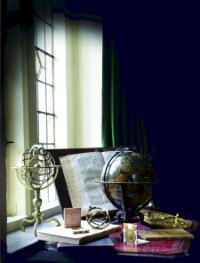Type: Book
Inv. No. n/a
Source: MHS
One of the most influential books on a scientific instrument ever to be published. As his title suggests, Stöffler treats the astrolabe as something to be made and used: first he takes his readers through the construction of an astrolabe, in the sense of laying out its patterns of lines; then he explains how it may be used, through a series of worked examples of solving problems in astronomy, horology and surveying. Many authors of the many books on mathematical instruments to be published in the 16th century followed Stöffler’s example.
At the opening on display, Stöffler sets out the seven ‘climata’ or ‘climates’ – the zones of latitude Ptolemy used to divide the inhabited world. Stöffler adopts the divisions as given by Johannes de Sacrobosco, marked by the ‘elevation of the pole’ (the angle of the celestial pole or the Pole Star above the horizon) in each ‘climate’. This zoning, linking the earth and the heavens, was commonly adopted in contemporary cosmography.
Previous: Claudius Ptolemy, Almagest
Next: Paper astrolabe by Peter Jordan

